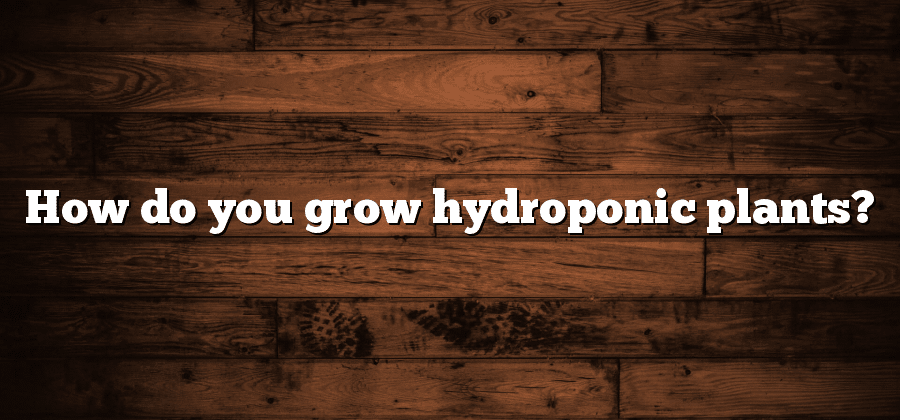Benefits of Hydroponic Plant Cultivation
Hydroponic plant cultivation offers numerous benefits that make it an increasingly popular choice among gardeners and farmers. One of the key advantages is the ability to grow plants in a controlled environment, free from the constraints of soil quality and outdoor weather conditions. With hydroponics, plants are grown in nutrient-rich water solutions, allowing them to receive the exact amount of nutrients they need for optimal growth. This precise control over the growing conditions leads to faster and healthier plant growth, resulting in higher yields and more productive harvests.
Another notable benefit of hydroponics is the efficient use of resources. Unlike traditional soil-based agriculture, hydroponics eliminates the need for large amounts of water and land. The water used in hydroponic systems is recirculated, meaning that it is constantly reused and minimizes water waste. Additionally, hydroponics requires significantly less land compared to conventional farming, making it a suitable option for urban areas or regions with limited available space. This resourcefulness not only contributes to environmental sustainability, but it also helps to reduce costs, making hydroponic plant cultivation an economically viable choice for both small-scale and commercial growers.
Essential Equipment for Hydroponic Plant Growth
Hydroponic plant growth requires the use of essential equipment to provide optimal growing conditions. One of the most important pieces of equipment is a grow tray or container, which serves as the base for the hydroponic system. These trays are typically made of durable materials such as plastic or fiberglass and come in various sizes to accommodate different plant types and quantities. Additionally, a water reservoir or tank is necessary to store and supply the nutrient solution to the plants. This reservoir should be made of non-toxic materials and equipped with a reliable pump system to ensure proper circulation of the nutrient solution.
Another indispensable piece of equipment for hydroponic plant growth is a grow light system. Since hydroponic plants cannot rely on natural sunlight, a carefully designed lighting setup is crucial to providing the necessary light spectrum for photosynthesis. LED grow lights are commonly used in hydroponic systems due to their high energy efficiency and ability to emit targeted light wavelengths. These lights should be adjustable in intensity and height to accommodate the specific growth stage of the plants. Additionally, timers can be installed to automatically control the lighting cycle and mimic natural day and night fluctuations.
Selecting the Right Growing Medium for Hydroponics
Hydroponic plant cultivation is gaining popularity for its efficiency and convenience. One of the key factors in successful hydroponic gardening is selecting the right growing medium. While soil is typically used in traditional gardening, hydroponics requires a different type of medium to support plant growth.
When selecting a growing medium for hydroponics, it is important to consider factors such as water retention, aeration, and pH stability. There are various options available, ranging from perlite and vermiculite to coco coir and rockwool. Each medium has its own advantages and disadvantages, so it is crucial to understand the specific needs of the plants you are growing.
Perlite, for example, is a lightweight volcanic rock that provides good aeration and drainage. It is ideal for plants that require a well-drained environment. On the other hand, coco coir is a renewable and sustainable medium made from coconut husks. It retains water well and is suitable for plants that prefer a more moisture-retentive substrate.
Rockwool, a popular growing medium in hydroponics, has excellent water retention and provides good root support. It is often used in commercial hydroponic setups. Vermiculite, another commonly used medium, has good water retention and can improve aeration when combined with perlite.
Choosing the right growing medium for hydroponics is critical for the health and growth of your plants. Before making a decision, consider factors such as the type of plants you are growing, their nutrient requirements, and the specific characteristics of each medium. By selecting the most suitable growing medium, you can ensure optimal conditions for your hydroponic garden and maximize the potential of your plants.
Understanding Nutrient Solutions for Hydroponic Plants
Hydroponic plant cultivation offers a unique and efficient way to grow plants without soil. Instead, plants are grown in water-based solutions that contain all the necessary nutrients for their growth and development. Understanding nutrient solutions is crucial for successful hydroponic gardening.
The key to a successful hydroponic system lies in providing the right balance of essential nutrients to the plants. These nutrients must be in a form that plants can easily absorb in order to support healthy growth and high yields. Nutrient solutions typically include essential elements such as nitrogen, phosphorus, and potassium, as well as secondary and trace elements like calcium, magnesium, and iron. These elements are carefully measured and mixed to create the perfect nutrient solution for each specific plant species. By providing the right combination of nutrients, hydroponic growers can optimize plant growth, increase yields, and enhance the overall health and vitality of their plants.
Proper Lighting Techniques for Hydroponic Gardens
Proper lighting techniques play a crucial role in the success of hydroponic gardens. Without adequate light, plants cannot undergo photosynthesis, which is essential for their growth and development. Therefore, it is important for hydroponic gardeners to understand the different lighting options available and how they can impact plant growth.
One of the most popular lighting options for hydroponic gardens is LED lights. LED lights provide a full spectrum of light that can be customized to meet the specific needs of different plants. They are energy-efficient, long-lasting, and emit very little heat, making them ideal for indoor gardening. Additionally, LED lights can be easily adjusted in terms of intensity and color, allowing gardeners to create the optimal lighting conditions for their plants.






